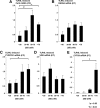Cord blood vitamin D status impacts innate immune responses
- PMID: 21470993
- PMCID: PMC3100757
- DOI: 10.1210/jc.2010-1559
Cord blood vitamin D status impacts innate immune responses
Abstract
Objectives: Our objectives were to 1) assess cord blood vitamin D concentrations from healthy term newborns, 2) ascertain whether cord blood vitamin D insufficiency precludes optimal induction of the Toll-like receptor (TLR) antimicrobial pathway in monocytes, and 3) determine whether in vitro supplementation with 25-hydroxyvitamin D(3) [25(OH)D(3)] and/or 1,25-dihydroxyvitamin D(3) [1,25(OH)(2)D(3)] restores TLR-induced antimicrobial responses.
Study design: Plasma concentrations of 25(OH)D and 1,25(OH)(2)D were measured from cord blood of 23 newborns. Human monocytes were cultured in cord blood plasma and stimulated with TLR2 and TLR4 ligands, and then antimicrobial gene expression was analyzed using quantitative PCR.
Results: Cord blood 25(OH)D and 1,25(OH)(2)D concentrations were positively correlated to each other (r = 0.78; P <0.0001). Compared with those conditioned in vitamin D-sufficient plasma [25(OH)D > 75 nmol/liter], monocytes cultured in severely vitamin D-deficient plasma [25(OH)D < 30 nmol/liter] exhibited decreased TLR-induced cathelicidin expression (P <0.05). Supplementation in vitro of vitamin D-deficient plasma with 25(OH)D(3) increased antimicrobial peptide gene expression.
Conclusions: Cord blood vitamin D deficiency, by its effects on TLR-induced antimicrobial production, altered in vitro monocyte responses. The observation that exogenous 25(OH)D(3) in vitro recovered TLR-induced antimicrobial responses suggests the need for additional prospective investigations to further delineate the role of vitamin D in the newborn immune response.
Figures




References
-
- Bryce J, Boschi-Pinto C, Shibuya K, Black RE. 2005. WHO estimates of the causes of death in children. Lancet 365:1147–1152 - PubMed
-
- Lubani MM, al-Shab TS, al-Saleh QA, Sharda DC, Quattawi SA, Ahmed SA, Moussa MA, Reavey PC. 1989. Vitamin-D-deficiency rickets in Kuwait: the prevalence of a preventable disease. Ann Trop Paediatr 9:134–139 - PubMed
-
- Ziegler EE, Hollis BW, Nelson SE, Jeter JM. 2006. Vitamin D deficiency in breastfed infants in Iowa. Pediatrics 118:603–610 - PubMed
-
- Kazemi A, Sharifi F, Jafari N, Mousavinasab N. 2009. High prevalence of vitamin D deficiency among pregnant women and their newborns in an Iranian population. J Womens Health (Larchmt) 18:835–839 - PubMed
-
- Rabbani A, Alavian SM, Motlagh ME, Ashtiani MT, Ardalan G, Salavati A, Rabbani B, Rabbani A, Shams S, Parvaneh N. 2009. Vitamin D insufficiency among children and adolescents living in Tehran, Iran. J Trop Pediatr 55:189–191 - PubMed
Publication types
MeSH terms
Substances
Grants and funding
LinkOut - more resources
Full Text Sources
Medical

